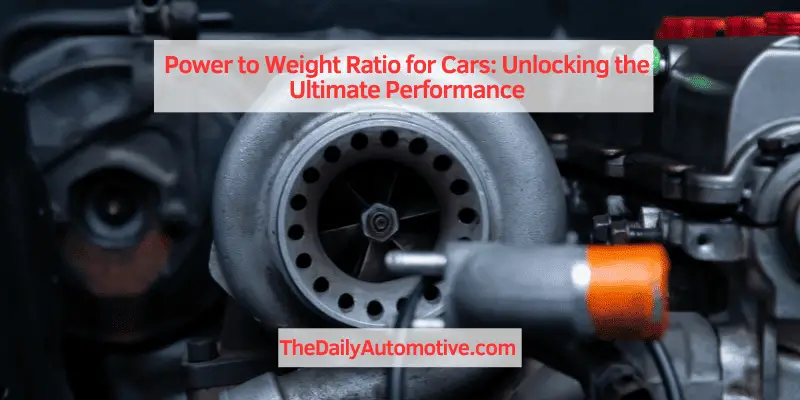Power to Weight Ratio for Cars: Unlocking the Ultimate Performance
The power-to-weight ratio for cars measures the relationship between a vehicle’s power and its weight. This ratio indicates how efficiently a car can accelerate and perform.
When it comes to evaluating a car’s performance, the power-to-weight ratio is a crucial factor. Essentially, it identifies how much power is available to move each unit of weight, which directly impacts the car’s speed and agility. A higher power-to-weight ratio generally means better performance, as the car has more power relative to its weight.
This can result in improved acceleration, responsiveness, and overall driving dynamics. Understanding the significance of the power-to-weight ratio can help car enthusiasts and buyers make informed decisions when evaluating a vehicle’s performance capabilities.
Understanding Power To Weight Ratio For Cars
Importance Of Power To Weight Ratio
The power to weight ratio of a car is a crucial factor in determining its performance. This ratio signifies the relationship between the power produced by the engine and the weight of the vehicle. It is an essential metric as it directly affects how agile and responsive the car will be on the road.
How Power To Weight Ratio Affects Car Performance
Power to weight ratio has a significant impact on a car’s acceleration, top speed, and overall handling. Cars with a higher power to weight ratio tend to be quicker in acceleration and have a higher top speed. Moreover, they are capable of greater agility and superior handling, making them more exhilarating to drive.
Engine Power
The power component of the power to weight ratio is derived from the engine’s output. A more powerful engine will naturally contribute to a higher power to weight ratio, resulting in a more dynamic driving experience.
Vehicle Weight Distribution
It’s not just about engine power; the weight of the vehicle also plays a pivotal role. The distribution of weight across the chassis affects the car’s balance and stability, influencing the power to weight ratio. A well-balanced weight distribution ensures that the power to weight ratio is optimized, enhancing the car’s performance on the road.

Credit: www.baronbmw.com
Calculating Power To Weight Ratio
Calculating the power to weight ratio of a car is essential for understanding its performance capabilities. The power to weight ratio is a key factor in determining a vehicle’s speed, acceleration, and overall agility on the road. It represents the amount of power generated in relation to the weight it needs to move, making it a crucial metric for car enthusiasts and engineers alike. In this section, we will delve into the important aspects of calculating power to weight ratio and its significance in the automotive world.
Definition Of Power To Weight Ratio
The power to weight ratio is a measure of the power output of a vehicle in relation to its weight. It is expressed as the amount of power produced per unit of weight, typically represented as horsepower per pound (hp/lb) or kilowatts per kilogram (kW/kg). This ratio is a fundamental indicator of a vehicle’s performance potential, with a higher power to weight ratio indicating better acceleration and speed capabilities.
Power Output
The power output of a car is the amount of energy it can produce to perform mechanical work. It is commonly measured in horsepower (hp) or kilowatts (kW). The power output is a critical component in calculating the power to weight ratio, as it directly influences the vehicle’s ability to accelerate and maintain speed. A higher power output translates to a stronger driving force, contributing to a higher power to weight ratio and improved performance.
Vehicle Weight
The weight of a vehicle plays a crucial role in determining its power to weight ratio. It includes the mass of the car itself, as well as the weight of occupants, cargo, and fuel. Reducing vehicle weight can positively impact the power to weight ratio, leading to improved acceleration and fuel efficiency. Conversely, a heavier vehicle will require more power to achieve similar performance, resulting in a lower power to weight ratio and potentially reduced agility and speed.
Enhancing Power To Weight Ratio
Enhancing the power to weight ratio of a car is crucial for achieving optimal performance. This ratio plays a fundamental role in determining a vehicle’s agility, acceleration, and overall driving experience. There are several ways to improve the power to weight ratio, ranging from enhancing engine performance to reducing the vehicle’s weight. Let’s delve into some of the most effective methods for enhancing this essential ratio.
Upgrading Engine Performance
One of the primary ways to enhance the power to weight ratio is by upgrading the engine performance. This can be achieved through various methods such as optimizing fuel delivery, improving airflow, and enhancing combustion efficiency. Upgrading the engine can significantly increase the power output without adding excessive weight to the vehicle.
Turbocharging
Turbocharging involves using exhaust gases to drive a turbine, which in turn compresses the intake air, resulting in increased power output without adding significant weight to the vehicle. This method is popular for enhancing the power to weight ratio, especially in high-performance applications.
Supercharging
Similar to turbocharging, supercharging involves compressing the intake air to boost power output. However, unlike turbochargers, superchargers are mechanically driven and provide immediate power, making them an effective way to enhance the power to weight ratio.
Reducing Vehicle Weight
Reducing the overall weight of the vehicle is a direct approach to improving the power to weight ratio. By incorporating lightweight materials and utilizing advanced construction techniques, the vehicle’s weight can be minimized, leading to better acceleration and handling.
Lightweight Materials
Using lightweight materials such as carbon fiber, aluminum, and high-strength steel can significantly reduce the vehicle’s weight without compromising structural integrity. These materials are increasingly utilized in high-performance vehicles to enhance the power to weight ratio.
Performance-oriented Modifications
Implementing performance-oriented modifications such as aerodynamic enhancements, suspension tuning, and brake upgrades can further optimize the power to weight ratio. These modifications not only improve performance but also contribute to achieving an optimal balance between power and weight.

Optimizing Power To Weight Ratio For Ultimate Performance
When it comes to achieving ultimate performance in cars, one of the crucial factors to consider is optimizing the power to weight ratio. This ratio has a significant impact on the acceleration, handling, and braking of a vehicle. Achieving the perfect balance of power to weight ratio is essential for different driving conditions, ensuring that the car delivers exceptional performance across various scenarios.
The Impact Of Power To Weight Ratio On Acceleration
The power to weight ratio directly influences a car’s acceleration. A higher power to weight ratio allows the vehicle to accelerate faster, achieving higher speeds in a shorter time. Reducing the weight of the car or increasing its power will improve its power to weight ratio, resulting in quicker acceleration and enhanced performance.
Influence On Handling And Braking
A well-optimized power to weight ratio also has a direct impact on the handling and braking capabilities of a car. With a favorable power to weight ratio, the vehicle can respond more effectively to steering inputs and maintain stability during cornering. Furthermore, a lower weight relative to the power output enables improved braking performance, leading to shorter stopping distances and enhanced control over the vehicle.
Achieving The Perfect Balance For Different Driving Conditions
For ultimate performance, it is essential to achieve a perfect balance of power to weight ratio tailored to different driving conditions. In scenarios where high acceleration is required, a higher power to weight ratio is beneficial. On the other hand, for precise handling and efficient braking, a lower overall weight relative to power is advantageous. Adjusting the power to weight ratio based on specific driving conditions ensures that the car delivers optimal performance and responsiveness across varying terrains and driving situations.
Frequently Asked Questions Of Power To Weight Ratio For Cars
What Is The Power To Weight Ratio Of A Car?
The power to weight ratio of a car is the measure of its engine power in relation to the vehicle’s weight. It determines the car’s performance, speed, and fuel efficiency, making it a crucial factor in overall driving experience.
How Does Power To Weight Ratio Affect A Car’s Acceleration?
A higher power to weight ratio enables faster acceleration as there is more power available to move the vehicle’s weight. This results in improved performance and responsiveness, allowing the car to reach higher speeds more quickly.
Why Is Power To Weight Ratio Important In Car Performance?
The power to weight ratio is critical in determining a car’s performance as it directly impacts its speed, agility, and overall driving dynamics. A high ratio results in better acceleration, handling, and fuel efficiency, providing a superior driving experience.
Conclusion
Understanding the power-to-weight ratio is crucial for unlocking a car’s performance potential. By evaluating this measure, you can make more informed decisions when purchasing or modifying a vehicle. A higher power-to-weight ratio translates to better acceleration and handling, underscoring its significance in the automotive industry.
Mastering this concept can empower you to elevate your driving experience.








